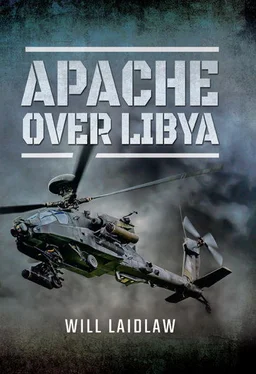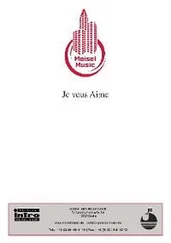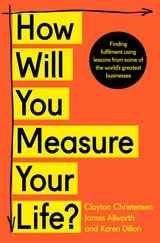To be sure, and perhaps part in response to the surging adrenaline, I fired a second Hellfire into the base of the mast before John pulled the aircraft away to the right. Still feet-wet, he set us up for another run-in as Nick and Little Shippers covered our break with a burst of 30mm. I brought the FLIR back on to the radar to check the damage. The radar had been completely destroyed, its buckled frame holding up a useless skeletal head. We were in; the first job was done.
‘Good BDA, target destroyed. RV at holding point two, prepare to move to target two.’ I told Nick to fly to a prearranged point over the sea and set up to run-in to the second target 10km to the east.
This target was a pro-Gad vehicle checkpoint on the main highway linking Brega to Misrata, the single continuous link between all the coastal towns in Libya. Pro-Gad owned the road and everything on it. To maintain control they needed checkpoints, but these were isolated, manned with few soldiers and open to attack. Safely behind their own front line they were clear of the rebels, but NATO could reach them from the air. With reconnaissance overflight confirming positions and military equipment, the CAOC was able to allocate this VCP to us to strike.
With my eyes inside the cockpit, I was busy reorganizing the MPDs and linking the navigation track to the VCP: ‘Tell him to follow us, trail left. We’ll give it a wide orbit to see what it looks like.’ I asked John to relay the information to Nick and Little Shippers and set off.
It was likely that the VCP soldiers had seen our Hellfire in the air and heard the strike on the radar site. It was possible that a coastal scout had alerted them. It was also possible that they were there to attempt to shoot us down. Whatever had alerted them, they were ready. As soon as we got within earshot the seven men on the VCP began rushing for their weapons, but they appeared leaderless. There was much hurrying about, but nothing actually happened. I held off shooting because although I could see weapons and soldiers, no one was looking hostile. After a few moments of uncertainty a pickup truck arrived from the direction of the radar site. A man got out of the truck and took command. Hostilities ensued.
Two men ran to a ramshackle sun shelter and drove a previously unseen technical out on to the road. On its flatbed sat a ZU-23-2. The anti-aircraft weapon was perfectly mounted and bright white in my infrared right eye. Excellent concealment, I thought to myself – no jet or Pred would ever see it on a fly-past. Only from our low angle could it be seen under its shelter. The men parked, jumped on the rear of the truck and began revolving the ZU-23-2. The leader and two more soldiers crouched beside the technical. Seconds later, sporadic flashes came spitting from the barrel as it ranged 23mm rounds around the clear night sky in our direction. The night flashed from white to black, white to black as the triple-A felt for us in the dark. No need for a stand-off any more; it was time to engage.
‘Weapon system on the truck!’ I transmitted. Then to John, ‘Get into constraints.’
I actioned the gun and squeezed the laser trigger to get a range and trajectory for the 30mm, while John tried to bring us on to the target. The technical was 70° out to the right, a very difficult shot. John tried to make the firing angle less acute, but pro-Gad interrupted with another burst of anti-aircraft fire from the ZU-23-2 in our direction. In self defence I squeezed the laser and gun triggers simultaneously, landing a quick burst in the vicinity of the technical but not deterring its action.
‘Your target!’ I burst on the net to Nick, as John began weaving to evade the incoming fire.
Little Shippers had his aircraft in perfect balance, with the technical directly to his 12 o’clock, giving Nick in the front seat an ideal 30mm firing solution. Laying his laser on to the technical, he fired four 20-round bursts of lethal 30mm, ripping up the ground around it, hitting the vehicle, destroying the ZU-23-2 and killing both the gunners. The three others threw themselves to the ground as the technical caught fire.
As the ammunition inside the vehicle started to heat and explode they ran, fell, dived, crawled and eventually sprinted out into the desert. I tracked them with my FLIR, gun actioned. Powered by adrenaline and fear for their lives, the lucky three kept running at impressive speed, legs high and arms pumping. I wanted to kill the leader – it was he who had directed his men to try and kill me – but I knew not to pull the trigger. It was far better to let pro-Gad military leadership, however junior, go free and tell his colleagues and commanders what had happened. If we were to have an effect in Libya it was going to be through witnessed lethal precision. This was the first time NATO and the regime had exchanged shots, had a fight. Up until now it had been whack-a-mole – jet on target, big height, no sound. No face-to-face fighting or fear. To cause problems for Gaddafi and the regime we needed his foot soldiers to be talking about us, we needed noise and we needed survivors.
With the runners heading out into the desert I returned my FLIR to the VCP. The technical was cooking off ammunition alarmingly, sending projectiles and shrapnel sideways and vertically. The fire burned so intensely that I was able to use the day camera sight to record the damage. All hell had visited and no one remained at the VCP. Our mission was complete, and as the receding noise of rotor blades sounded in the survivors’ ears we turned for the sea once more.
‘We’re done here. Turning north for Mother, my lead.’ I guided the patrol back out to sea. Once clear of the coast and out of range of Libya, I set the navigation to track Ocean ’s recovery point. While we were airborne she had moved to the prearranged pickup point and was now readying to receive us back on deck. John and Little Shippers pulled in the power, increased our speed, and we found Ocean in just six minutes. With plenty of fuel and a cautious approach we landed in turn, sticking rigidly to the new armed, night-landing procedures Wings and Big Shippers had designed.
With both aircraft on deck and lashed down, John and Little Shippers brought back the engines, and the rotors slowed to a full stop. With all switches set, weapons triple-safe and saying, ‘All done, switching off,’ John turned off our battery. I sat, helmet still on, eyes closed, in silence. Brief, perfect silence. We’d gone there, had a fight and come back. Relief and the elation of survival and success settled on me. I knew the others would be feeling it too.
The ground crew soldiers removed the remaining Hellfire. Once they had finished, the lead lance corporal tapped on the canopy, startling my eyes open: ‘Sir, there’s an empty 30mm case from the gun, do you want a souvenir?’ I nodded, no words needed. He handed me the empty case and I tucked it into my pocket.
I climbed down on to the flight deck. The engineers and the ground crew were already getting to work, folding the blades and moving the aircraft into the hangar. Ocean headed north for safer waters and half a dozen journalists wanted to hear about what had happened. First, I needed to debrief with all the aircrew and write the Mission Report (MISREP). We went down to the flip-flop and played back the guntape.
Guntape debriefs are usually private meetings between the owner of the trigger pull and his senior commander. Killing and then replaying the killing, examining the weapon effect and describing the fight are deeply personal moments. However, the intensity of the scrutiny could not be avoided, and the Commodore and even the Padre came down to the flip-flop to listen to the debrief. All the aircrew were there too. This time the guntape debrief had to be much wider. In a new war everyone has to know what happened first. To the aircrew it might give them their one chance at winning later. Both Nick and I both felt uneasy, with the Padre present, describing the precision of Hellfire, the fragmenting effect of 30mm and killing. Guntape debriefs are analytical and dispassionate. Their purpose is to review the facts, and check the ROE and the gunnery; they can take up to two hours. They are about logic and reason, but they also acknowledge the moral responsibility of having killed. We had risked our lives, been shot at and taken lives. All these things weighed heavily with us and, as they always do, they would take a long time to settle in our heads afterwards. Killing never leaves your mind, it can’t be unseen, and you will always remember it. Its memory visits your dreams and sometimes in the daytime too. That night we had to kill to stay alive and we knew there would be more in the coming days.
Читать дальше












